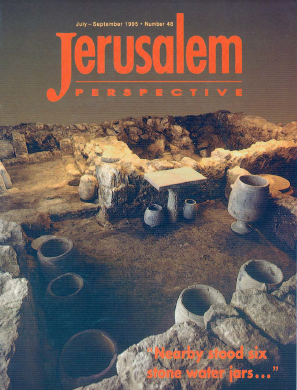Question from Mrs. C. M. Didsbury (Uphill, Weston-Super-Mare, Avon, England) that was published in the “Readers’ Perspective” column of Jerusalem Perspective 48 (Jul.-Sept. 1995): 8.
After reading Marvin Wilson’s “Jewish Laws of Purity in Jesus’ Day” (Jerusalem Perspective 37 [Mar.-Apr. 1992], 11, 17), I must admit to finding the reality of the situation of women (e.g., anyone touching anything she sits on during menstruation, to be also unclean) depressing. How did women express their spirituality? Did they have any power? Mary was a woman. God loved and used her.
Chana Safrai responds:
In discussing Jewish regulations of ritual purity, one should not forget that this system of laws is biblically based. Scripturally, there are five causes of uncleanness:
- Contact with a dead body (Num. 19:11-22).
- Contact with the carcasses of living creatures (Lev. 11:23-44).
- Bodily discharges including emission of semen, menstrual flow (Lev. 15) and the woman’s bleeding at childbirth (Lev. 12).
- Skin diseases (Lev. 13-14).
- Contact with sanctified space or objects. Those who prepared the ashes of the red heifer became ceremonially unclean as a result of their holy labor (Num. 19:1-10); the high priest was required to bathe himself with water between his various duties on the Day of Atonement (Lev. 16:4, 23-24).
The Hebrew expressions טָהֳרָה (ṭo·ho·RĀH, “cleanness,” “purity”) and טֻמְאָה (ṭum·’ĀH, “uncleanness,” “impurity”) are technical terms that have no positive or negative connotations. Scripturally, one is either in a state of purity, or not in a state of purity. Uncleanness is a human phenomenon, almost commonplace, and one must view the contrast between clean and unclean as a contrast between that which is holy and that which is not (Lev. 11:47), between that which is divine and that which is human. Ritual cleanness and uncleanness should not be thought of as a contrast between good and evil.
Furthermore, regulations pertaining to cleanness and uncleanness do not single out women. There are types of uncleanness specific to men, and there are types specific to women, but most apply to both sexes.
Feminists have often failed to recognize these distinctions. Biblical regulations pertaining to ceremonial cleanness do not negate a woman’s religious experience; they emphasize unique feminine life experiences (gender appreciation). Thus, after giving birth, a woman made a pilgrimage to the Temple in Jerusalem to bring the prescribed sacrifice and to purify herself. She did not come with a sense of guilt, but came celebrating a distinctive feminine experience. Her religious ceremony in the Temple was a celebration of femininity.
The biblical prophets (especially Ezekiel) and poets sometimes employed the terms “clean” and “unclean” as metaphors for good and evil: “And he will cast pure water on you and you will be clean” (Ezek. 36:25); “Cleanse me from my iniquity and purify me from my sin” (Ps. 51:4). Perhaps “clean” and “unclean” were already used metaphorically in the Pentateuch in the passage about unlawful sexual relations (Lev. 18). In this passage, a connection is made between detestable pagan practices and ritual impurity, and God’s demand that the Israelites keep themselves undefiled by not engaging in such practices.
Joseph Frankovic adds:
It is nearly impossible in English to find a one-word equivalent that adequately expresses the sense of the biblical and rabbinic technical term טָמֵא (ṭā·MĒ’). Most one-word equivalents used to translate ṭā·MĒ’, such as “unclean” or “impure,” carry a conspicuous negative prefix. However, the term does not convey a sense of moral judgment unless the state of impurity has been achieved by an act proscribed by Torah. The term may simply mean incompatibility with or unreadiness to enter God’s sphere (e.g., the Temple sanctuary).
Perhaps a helpful way to grasp one nuance of the term’s meaning is by analogy. In designing a house, one does not put the dining room next to the bathroom. The activities of the bathroom do not complement those of the dining room. Neither bathroom nor dining room activities, however, are sinful, just incompatible. Also, note carefully Saul’s assumption about David’s absence at the royal meal (1 Sam. 20:26). He seems to arrive at his conclusion about David with no hint of alarm or disgust.

Joseph of Arimathea (Luke 23:53, and parallels) took Jesus’ body down from the cross, wrapped it and laid it in a rock-hewn tomb. He became ceremonially unclean through this contact with a corpse. His ritual state was a result of his righteous behavior. If one is to take Jesus’ humanity seriously, then one must assume that Jesus went through cycles of being ceremonially clean and unclean. Whether Jesus, at a given moment, was “clean” or “unclean” said nothing about his moral character. The vast majority of New Testament scholars believe that Joseph (Mary’s husband) died before Jesus began his public ministry. Did Jesus participate at his father’s funeral? Did he come in contact with Joseph’s corpse? If he did, then he too, through this caring deed, would have become ritually impure.[1]
- [1] On the possibility that Jesus himself occasionally became ritually impure, see JP Staff Writer, “What’s Wrong with Contagious Purity? Debunking the Myth that Jesus Never Became Ritually Impure,” Jerusalem Perspective (2024) [https://www.jerusalemperspective.com/29371/]—JP. ↩





![Chana Safrai [1946-2008]](https://www.jerusalemperspective.com/wp-content/uploads/userphoto/34.jpg)





























































































